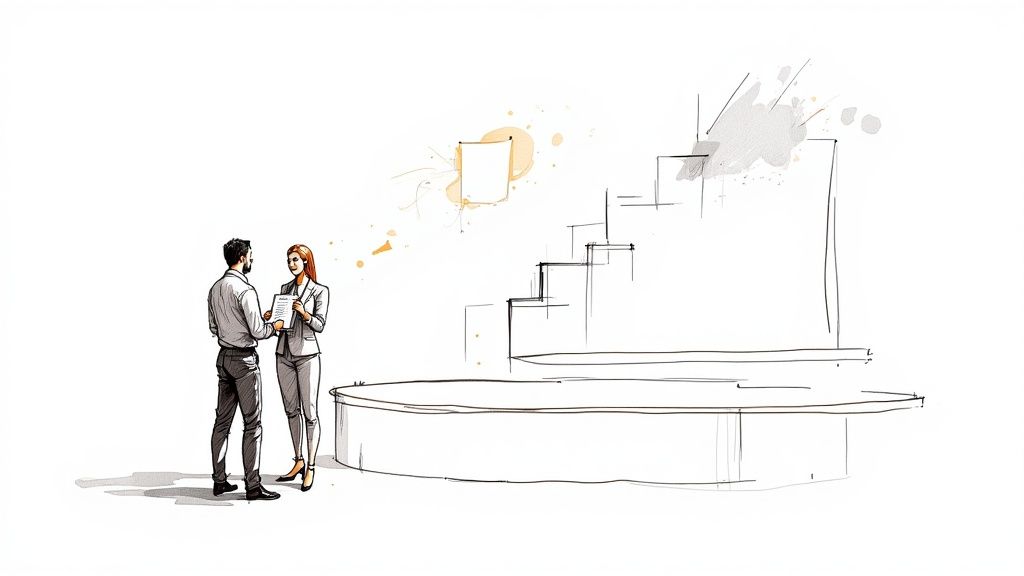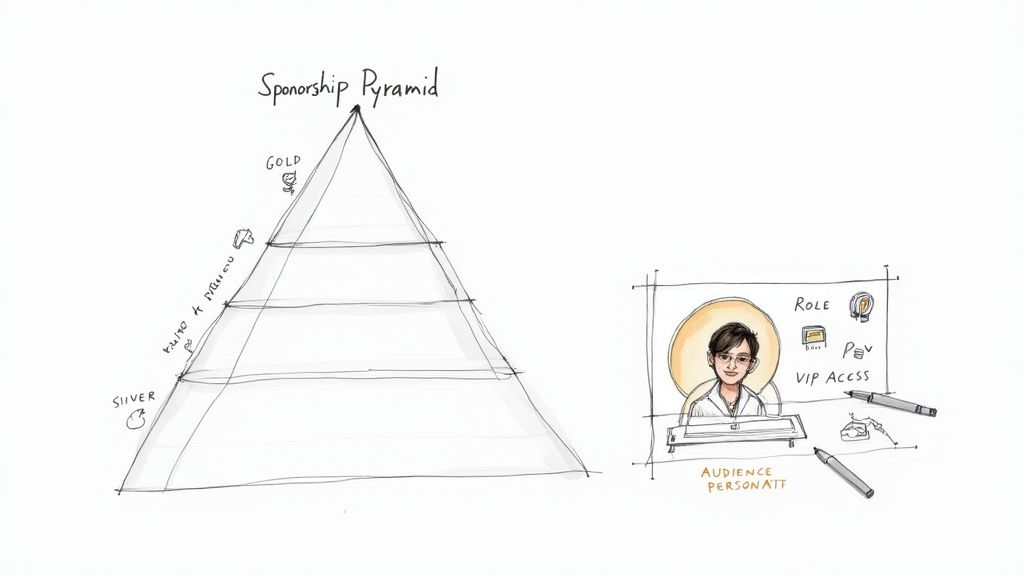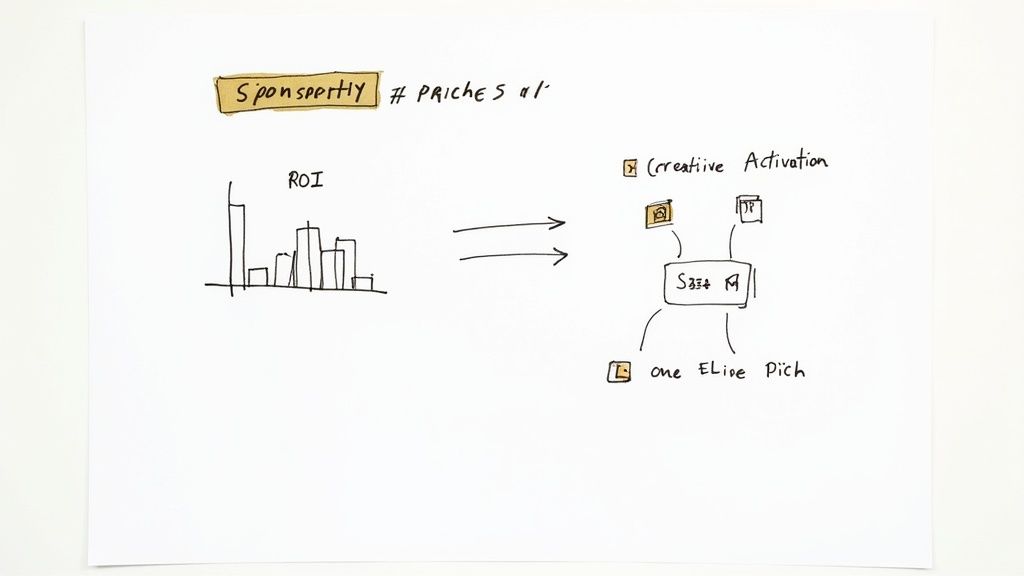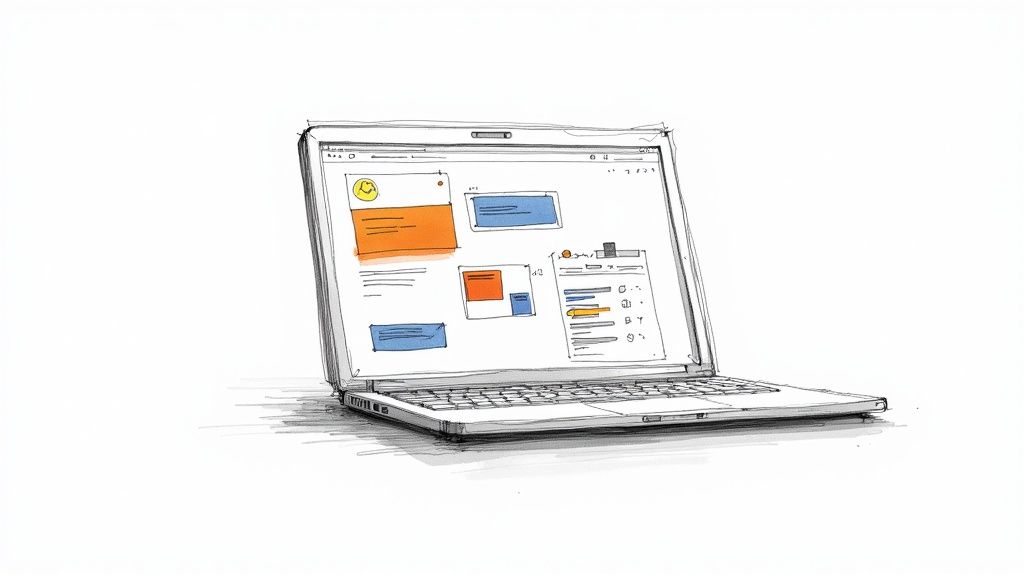October 30, 2025

Before you even think about writing a pitch email or picking up the phone, the real heavy lifting for securing event sponsors happens behind the scenes. Let's be clear: getting sponsorship isn't about asking for a handout. It's about selling a powerful marketing opportunity.
Potential sponsors get hit with requests all day long. To cut through that noise, you have to shift your mindset. Stop thinking about what you need and start focusing entirely on what they want.
The whole game depends on seeing your event through a sponsor’s eyes. They aren’t just giving you money; they're buying access to your audience. They need to see a clear path to a return on their investment, and it’s your job to build the business case that gets them there.
Here's where you lay the groundwork. Get this part right, and the rest of the process becomes infinitely easier.
So, what makes your event a must-attend? You have to dig deeper than just attendance numbers. For example, a sponsor will see far more value in a niche cybersecurity conference with 200 high-level CISOs than a general community festival with 2,000 attendees. The value is in the quality of the connection you offer, not just the quantity of people.
Think about the unique experiences you can provide that a simple ad campaign can't:
This is all about framing your event as an unmissable opportunity.

As you can see, defining your value is the absolute base of the pyramid. From there, you layer on audience understanding, which then allows you to build packages that actually sell.
Let's get one thing straight: sponsors aren't buying your event; they're buying access to your audience. Your job is to paint an incredibly vivid picture of who these people are. Vague descriptions like "tech professionals" are a waste of time. You have to get specific.
A detailed audience profile is your most powerful asset. It’s not just about demographics; it’s about psychographics—their challenges, goals, and purchasing behaviors. This data proves you can deliver their ideal customer.
Start gathering hard data. What are their job titles? What’s their purchasing power? Which industries do they represent? Where are they located? Run pre-event surveys asking what tools they use or what business problems keep them up at night. This intel is pure gold because it lets you connect the dots between your audience's problems and a sponsor's solutions.
With a clear value proposition and deep audience knowledge, you can now build your sponsorship packages. It's time to move beyond just slapping a logo on a banner. Today’s sponsors expect meaningful activation opportunities that deliver tangible results.
Think about building packages that solve their biggest marketing challenges:
Structuring these benefits into different tiers makes the decision-making process much smoother for sponsors.
Building out sponsorship tiers is where you translate your event's value into clear, purchasable options. Here’s a sample breakdown to give you a starting point for structuring your own packages.
Remember, these are just examples. The key is to make each tier a logical step up in value, giving potential sponsors a clear choice that fits their budget and goals. This foundational work ensures your outreach is targeted, professional, and far more likely to get a "yes."

Forget the old "spray and pray" method of sending generic emails to every company you can find. Securing real sponsorship isn't about volume; it's about smart matchmaking. Your goal should be to build a hand-picked list of companies that genuinely connect with your event, your audience, and what you stand for. This targeted approach is what turns your pitch from inbox clutter into a compelling opportunity.
The best partnerships are always built on common ground. A great place to start is by asking, "Who already wants to reach my audience?" If you're organizing a local marathon, a big shoe brand is an easy one. But what about the local physical therapy clinic? Or the startup making organic energy bars? Or even the financial advisor who specializes in helping young professionals? These businesses have a built-in interest in connecting with the very people you're bringing together.
The absolute first test for any potential sponsor is audience alignment. You aren't just looking for deep pockets; you need to find companies whose ideal customer is sitting in your event’s seats. A bad audience fit is the fastest way to get your proposal ignored.
Think of it this way: a sponsor isn’t just buying a logo on a banner. They're buying access to a room full of their ideal customers. Your job is to prove that your attendees are precisely the people they've been trying to reach.
This is where knowing your audience inside and out pays off. If your conference draws C-level executives from the tech world, a business selling enterprise software is a natural fit. But a company selling gaming headsets? Probably not so much.
Companies that have sponsored similar events before are your hottest leads, period. Their marketing teams already get the value of event marketing, and more importantly, they have a budget for it. You’re not trying to convince them to try something new; you’re just showing them a better, more targeted opportunity with your event.
A little bit of detective work goes a long way here:
This kind of research does more than just give you a name. It gives you intelligence you can use in your pitch, letting you reference their past sponsorships to show you’ve done your homework. For a more detailed breakdown of these tactics, our guide on how to find corporate sponsorship digs even deeper.
https://groupos.com/blog/how-to-find-corporate-sponsorship
Once you have a healthy list of potential sponsors, it’s time to get strategic. Not all prospects are created equal, and you need to focus your energy where it will count the most. A simple spreadsheet can help you rank them and find your top-tier targets.
Give each prospect a score from 1 to 5 on a few key factors.
By scoring your prospects, you’ll quickly see who your "Tier 1" targets are—the ones with the highest chance of saying yes. This lets you dedicate the time and effort required to build a truly personalized proposal for the companies that matter most.
Think of your sponsorship proposal as your foot in the door. A generic, one-size-fits-all document is the fastest way to get ignored. If you want a response, your proposal has to be a custom-built solution for a sponsor's specific business challenges, not just a menu of prices.
It's less of a request for money and more of a compelling business case. From the moment they open it, your proposal needs to answer their silent, all-important question: “What’s in it for me?” This means every single word, from the executive summary to the sponsorship tiers, has to be tailored to their brand, their audience, and their marketing goals.
The first page decides if the rest even gets read. Ditch the generic intro and lead with a personalized summary that proves you've done your homework. Reference a recent marketing campaign they launched, mention a company value that resonates with your event, or point out a specific audience segment you both share.
For example, instead of saying, “Our tech conference is a great opportunity,” try something like this: “We saw your recent campaign focused on upskilling developers. Our conference attracts over 500 senior developers actively looking for new tools, which seems like a direct channel to your ideal customers.” See the difference? You’ve instantly framed your event as a solution.
Sponsors need to see the numbers, but they need them in context. Don’t just dump a list of your attendee demographics and call it a day. You need to present your audience data as the answer to their marketing problems. They aren't just buying access to a crowd; they're buying access to potential customers with very specific needs.
A great proposal doesn’t just share data; it tells a story with it. It connects the dots between who is attending your event and who the sponsor wants to sell to, making the partnership feel like an obvious strategic move.
Sponsorship strategies are always evolving. Right now, showing a real commitment to diversity and social responsibility is a massive factor for brand alignment. And of course, measurement is more important than ever. Sponsors need to see a clear return on their investment. Getting familiar with the latest global sponsorship trends will help you position your proposal perfectly.
This is where you can really set yourself apart. Instead of just offering the standard logo placement on a banner, brainstorm one or two creative activation ideas tailored specifically for them. This shows you’re thinking about their success, not just cashing their check.
These custom ideas signal that you're a true partner invested in their ROI. A lot of the same strategies apply to other funding requests, and you can learn more about the fundamentals in this guide on how to write funding proposals that actually win. While it's geared toward grants, the core principles of telling a strong story and proving value are exactly the same.
If you need to see how all these pieces come together in a real-world document, check out this sample sponsorship proposal.

A fantastic proposal might get your foot in the door, but it's the human connection you build during the pitch and follow-up that truly closes the deal. This is where all your research and preparation come to life, turning a cold outreach into a genuine conversation. Your goal isn't just to present; it's to connect.
The first step is often the trickiest: finding the right person. Job titles can be a smokescreen. The "Marketing Director" might seem obvious, but the "Community Engagement Manager" or "Brand Partnerships Lead" could be the one who actually controls the budget. I always use LinkedIn to find the real decision-maker—look for someone who has a history of engaging with or posting about events.
Your initial email needs to be sharp and personal. Whatever you do, don't attach your full proposal right away. That’s a classic rookie mistake. Instead, write a short, compelling message that shows you've done your homework and has one simple goal: to get a quick call on the calendar.
Once you land that meeting, your mission is to flip the script. This isn't a sales pitch; it's a collaborative brainstorm. Trust me, nobody wants to sit through a monologue about how great your event is.
The best pitches I've been a part of were 80% listening and only 20% talking.
Start by asking open-ended questions. Get them talking about their marketing challenges and what they're trying to achieve this year. What's keeping them up at night?
As they open up, you can tailor your pitch on the fly. If they mention a struggle with lead quality, you can pivot to how a sponsored workshop puts them in a room with their ideal, pre-qualified customers. See how that works? You’re not just asking for a check; you're actively solving their problems.
A pitch meeting should feel like a strategy session, not a presentation. When a potential sponsor sees you as a partner invested in their success, they’re far more likely to invest in your event.
Let’s be real: getting a "yes" on the first call is incredibly rare. The real work starts with your follow-up game. You need a strategy that's persistent without being annoying—a fine line to walk, but crucial. A thoughtful, well-timed sequence of check-ins keeps the conversation going and shows you mean business.
Here’s a simple, effective rhythm I've used for years:
This structured approach respects their time while keeping your event on their radar. It’s that professional persistence that so often separates a "maybe" from a signed contract.
Event sponsorship used to be all about physical banners and conference booths. But as events have evolved, so have the opportunities for sponsors. The shift to virtual and hybrid formats has unlocked a whole new playbook for brands to connect with their audience in ways that are both creative and incredibly measurable.
Instead of getting hung up on what’s lost from a purely in-person experience, it's time to focus on the unique digital assets you can now offer. The key is to weave sponsors into the fabric of the event so they feel like a natural part of the experience, not just a glorified pop-up ad. It's all about creating genuine value for your attendees and your sponsors.
Let's move beyond just sticking a logo on the event homepage. The real magic happens when you create interactive and engaging activations that deliver tangible results for your partners.
Here are a few ideas to get you started:
And don't forget the power of a physical touchpoint, even for a digital event. Thinking about how effective promotional products can extend brand visibility can be a game-changer. A well-chosen gift sent to VIP attendees creates a memorable, tangible connection that bridges the digital divide.
Here’s where virtual and hybrid events have a massive advantage: data. The wealth of information you can collect is your single most powerful tool for proving ROI to sponsors. You can finally shift the conversation from fuzzy "impressions" to hard, concrete metrics.
The beauty of virtual sponsorship is its trackability. You can provide sponsors with hard data on audience engagement, click-through rates, and qualified lead generation—metrics that are often difficult to capture at a physical event.
This isn't just a fleeting trend. The virtual event market is set to explode, projected to hit $236.69 billion by 2025. What's more, 63% of organizers are already planning to increase their investment in digital formats. This data clearly shows sponsors that online events are not just a cost-saving measure but a powerful avenue for achieving higher ROI.
Your sponsorship packages need to reflect this data-first mindset. Promise detailed post-event reports that go beyond vanity metrics. Show them exactly how many people downloaded their whitepaper, how many requested a demo, and who actively participated in their sponsored session. This all starts with choosing from the best virtual event platforms, as the right tech is what gives you the robust analytics needed to deliver these powerful insights.

Getting that verbal "yes" from a sponsor feels amazing, but don't pop the champagne just yet. This is where the real work of turning a deal into a genuine partnership begins. Your job now is to deliver on every single promise you made and set the stage for a relationship that lasts for years, not just for one event.
The very first thing you need to do is get everything in writing. A formal sponsorship contract is your best friend—it protects you, it protects them, and it eliminates any chance of "he said, she said" down the road. This document is the blueprint for your entire partnership.
A rock-solid contract isn't optional; it's essential for preventing headaches later. It sets crystal-clear expectations for what you'll provide and what they'll pay. While having a lawyer look it over is always a smart move, every good contract needs to cover a few key bases.
Make sure your agreement clearly spells out:
A well-crafted contract isn’t about mistrust; it’s about creating clarity. It ensures both you and your sponsor are perfectly aligned on the partnership's scope, which is the foundation for a seamless experience.
Once the ink is dry, it's all about execution. The experience a sponsor has at your event is the single biggest factor in whether they come back next year. My best piece of advice? Give them a single, dedicated point of contact.
This person is their go-to for everything. Logistical questions about their booth, tech checks for a virtual presentation, last-minute requests—it all goes through one person who can make them feel like a true VIP. You can't over-communicate here. Check in before the event, walk the floor to see them during the event, and follow up immediately after. Make them feel seen and valued.
After the confetti settles, you have one last critical job: prove their investment paid off. This is where a comprehensive post-event report comes in. It’s your chance to back up your promises with cold, hard data and show them a tangible return on their investment. A fantastic report is what turns a one-time sponsor into a recurring partner. Our guide on measuring event ROI can give you a much deeper look into the specific metrics that sponsors really care about.
The sponsorship world is booming. Projections show the global sports sponsorship market alone could hit $132.86 billion by 2033. This massive growth means sponsors have more options than ever, so they’re looking for partnerships that deliver real, measurable value. A killer post-event report is how you prove you're one of them.
If you're diving into the world of event sponsorships, you’ve probably got questions. It’s a space filled with its own rules and rhythms. I've been there, and I've seen the same questions pop up time and time again.
Let's break down some of the most common hurdles so you can build your sponsorship strategy with confidence.
This is a big one, and the answer can make or break your efforts. My golden rule? Start your outreach at least 6 to 9 months before your event date. It sounds like a lot of time, but you have to remember how big companies operate. Many of them lock in their marketing and sponsorship budgets for the entire next year in the fall. If you show up in January asking for money, you might already be too late.
Getting on their radar early means you're part of the conversation while they're deciding where to allocate their funds, not after the fact.
Now, if you're targeting smaller, local businesses, you have a bit more wiggle room. Their budget cycles are usually more flexible. For them, a lead time of 3 to 4 months is often plenty.
Hands down, the biggest mistake is sending a generic, copy-and-paste proposal. You know the one—it has a spot for "[Sponsor Name Here]" and a list of benefits that could apply to any company.
Sponsors can smell a template from a mile away. It tells them you haven't bothered to learn about their brand, who they're trying to reach, or what their current goals are. It’s an instant turn-off.
Here’s the key: You need to transform your pitch from a generic ask into a compelling business case. Always, always customize your proposal to solve a specific problem for them. Show that you understand their challenges and that your event offers a unique solution.
This isn't just about being professional; it's about showing you're serious about creating a real partnership. That personal touch is what gets you a "yes."
Pricing is more of an art than a science, but it should never be based solely on your event's expenses. Your price needs to reflect the value you're delivering. A great starting point is to do some market research. See what similar events in your city or industry are charging. This gives you a competitive baseline to work from.
Once you have that baseline, you need to layer on the unique value only your event can offer. Ask yourself:
Come to the table with a well-researched price, but always be ready to have a conversation. The best deals are often negotiated when you build a custom package that perfectly fits a sponsor's needs.
Juggling sponsorships, attendees, ticketing, and all the other details is a massive undertaking. GroupOS is an all-in-one platform built to take that chaos and simplify it. It handles everything from membership and ticket sales to sponsor management and post-event analytics, freeing you up to do what you do best: create an unforgettable experience. See how GroupOS can streamline your next event.


